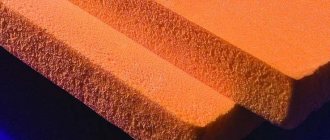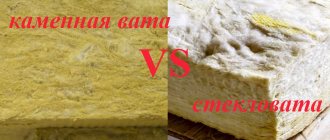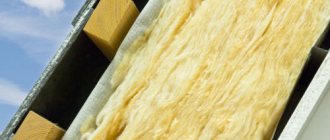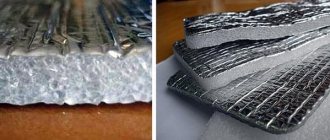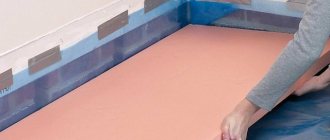Various types of insulation materials are used in the construction industry. They have their own characteristics, characteristics and installation technology. Among them, new generation building insulation materials are gaining the most popularity. These include expanded polystyrene, mineral wool and penoplex. The well-known glass wool does not give up its position and is successfully used in the construction of industrial premises and residential buildings.
Glass wool is used in various types of house construction, does not require special skills for installation and has excellent thermal insulation and sound insulation qualities. It is a universal insulation material and has high strength, elasticity and resistance to vibration. Glass wool is necessary for external and internal work, when installing pitched roofs and insulating horizontal surfaces. It can be used to seal gaps and cracks in walls. Glass wool is available in different forms - rolls or slabs. Many experts successfully use the material in practice, but do not even take into account the harmful properties of glass wool.
Features of windows
Windows made of PVC (polyvinyl chloride) have the ability to adjust the shutter elements and hinges during operation, which must be carried out without fail regardless of the quality of the product
. Every season it is important to evaluate the condition of the fittings, the opening and closing of the sash for the likelihood of jamming. This will save money on major repairs in the event of a breakdown, as well as ensure good functionality and durability of the product.
You can adjust plastic windows yourself without involving specialists, but you will need the appropriate tools.
When using a window, problems often arise with fittings or gaskets resulting in drafts in the room. In some cases, you can get by with manipulating the hinges or closure mechanisms, but sometimes a complete replacement of the devices is required
It is important to understand why adjusting metal-plastic windows at home
Results
Mineral wool is a safe material, and its health hazards are greatly exaggerated. Of course, there are types that create a lot of dust during installation, but this can be solved by using a respirator. The dust is subsequently neutralized by a vapor barrier film. There are prickly materials that make your skin itch. But again, if safety precautions are followed during installation, this problem does not arise. And the fact that mineral wool contains phenol-formaldehyde does not mean that it somehow leaves the structure of the material. In addition, this component is present in all plastics, not to mention other materials.
Manufacturers such as Knauf and Ursa have a line of materials that use an acrylic-based substance as a binder. This insulation is definitely safe. If these arguments are not enough, then you can insulate with natural materials of natural origin, for example, sawdust, straw or expanded clay.
Main characteristics
Let us describe the properties of basalt insulation in technical language.
Thermal conductivity
The thermal conductivity coefficient of basalt insulation of various brands varies from 0.034 to 0.048 W/m*C. To date, these indicators are considered the best. Porous thermal insulators made of polymers – foam plastics – have approximately the same thermal conductivity.
Vapor permeability
Stone wool easily passes through water in a gaseous state - its vapor permeability is 0.3 - 0.6 mg/m*h*Pa.
Whether this is an advantage or a disadvantage depends on the specific situation.
If the house is built according to European standards, according to which the walls must be made vapor-tight, then this property of the heat insulator is not necessary.
But in this case, to remove excess humidity, you will have to increase the air exchange rate, which will provoke an increase in heat loss. In domestic construction traditions, it is customary to make walls vapor-permeable, which reduces the intensity of ventilation, and therefore heat loss.
With this technology, the insulation must have greater vapor permeability than the main wall material. Then walls made of brick, gas and foam concrete (vapor permeability - from 0.11 to 0.17 mg/m*h*Pa) can only be insulated with mineral wool.
Fire resistance
All wool of mineral origin are non-flammable materials, but basalt insulation is special in this regard, as it has the highest melting point.
Softening of the material begins at a temperature of 1114 degrees.
Thanks to this property, the material looks very advantageous against the background of foam plastics, which burn very well, and even if they have fire-retardant additives, they still smoke a lot during a fire.
Strength
Today, stone wool is produced not only in the form of low-strength mats, but also in the form of slabs, in which the compressive strength can reach 80 kPa (deformation does not exceed 10%). Such slabs can be used to insulate existing flat roofs from the outside.
Density
One cubic meter of stone wool, depending on the brand, can weigh from 30 to 400 kg. The lightest varieties with a density of 30 - 50 kg/cu. m are used for internal insulation, the heaviest ones are used for external insulation. For floor insulation, material with a density of 150 kg/m3 is used. m.
Moisture resistance
The most important disadvantage of all fibrous heat insulators is hygroscopicity: they absorb water well, which leads to a significant loss of thermal resistance.
Basalt wool is an exception. At the production stage, its fibers are treated with oils, as a result of which it becomes hydrophobic.
The water absorption rate for most varieties is in the range of 1% - 5%, and only for some brands it can reach 20%.
We must not forget that moisture can enter the structure of basalt wool in the form of steam and condense there. In this case, the insulation, even despite its moisture resistance, will get wet and stop retaining heat.
To avoid such problems, the insulated structure must be calculated in a special program - a thermal calculator (there are many versions, some online).
If the calculation shows that a large amount of condensation will form inside the wool, it must be covered from the room side with a vapor barrier film.
Noise absorption
Unlike rigid foam plastics (except for polyethylene foam), all mineral wool insulation is soft. Thanks to this, they are good sound insulators. Thus, using basalt insulation, the user solves two problems at once - thermal insulation and sound insulation.
Resistance to active biological environment
The importance of this property of mineral wool in general and basalt wool in particular cannot be overestimated. The material is not afraid of any pests - from bacteria and fungi to rodents. Not all heat insulators can boast of this quality. Foam plastic, for example, is affected by mice, which like to build entire passages in them.
Advantages of glass wool, its “advantages”
- good thermal insulation properties;
- has soundproofing properties, it protects well from external noise
- resistance to biological factors, it is not chewed by mice, rats and other pests;
- environmental safety and cleanliness, it is harmless to health;
- is a fireproof material, does not burn and does not support combustion;
- resistant to mold, mildew, corrosion;
- It weighs little and does not put a load on the load-bearing elements of the structure, provides ease of transportation and the possibility of quick installation “alone”;
- It has a low cost and is budget friendly.
Photo 2. Glass wool for thermal insulation is usually used in rolls; it is resistant to mold and rodent attacks
Pros and cons of the material
The structure of the material resembles solidified lava, but more airy. In fact, basalt is lava, which is processed to produce cotton wool. During volcanic eruptions, huge amounts of small rock particles are released into the air.
If ecowool is produced according to technological standards and has the appropriate strength, then it will not crumble, and accordingly, the number of its particles in the air will be minimal, which is safe for health. And when using low-quality material, fine dust floats in the air, gets onto the body, mucous membranes, and also into the lungs, provoking the development of chronic respiratory diseases.
This is useful: basalt or mineral wool.
Under no circumstances should you save money by buying low quality material. Cheap insulation materials crumble upon direct contact with a tool or human hands. The negative impact begins with the following sensations:
- eye irritation;
- difficulty breathing, shortness of breath;
- itching on exposed skin.
In case of prolonged interaction with stone wool, harm from it can cause vision problems and even cancer. And technologically correctly manufactured basalt wool does not cause the above problems, since it has good strength and does not crumble. It has the following positive characteristics:
- long shelf life;
- additional sound insulation;
- increased fire resistance;
- the lowest possible thermal conductivity values.
Therefore, you should set your priorities correctly and buy safe, certified insulation.
Harmful fumes
In addition, in case of improper processing and non-compliance with technical standards, the produced ecowool contains additional resins. These are various chemical compounds, phenols and formaldehydes, used to bind fibers more effectively. When heated, they can evaporate and enter the human lungs, which is harmful to health. And long-term work at facilities with excess harmful substances in the air leads to the appearance of oncology and other diseases.
Therefore, production standards are mandatory to comply with. If everything was done correctly, then the material will be of high quality.
Main Differences Between Glass Wool and Stone Wool
So, the house is ready for insulation, but you still haven’t decided on the choice of thermal insulation. The main question sits in your head: should you buy newfangled stone wool, which is recognized by 70% of consumers around the world, or take old-fashioned glass wool? Let's determine the main factors that distinguish these thermal insulation materials from each other:
- Raw materials. Glass wool is blown from a synthetic material - a low-melting charge (glass production waste and broken glass). Stone wool is also produced from rocks based on basalt - a natural, environmentally friendly raw material, therefore it is successfully used for insulating residential premises.
- Non-flammability. Despite the fact that both materials are recognized as non-flammable, stone wool is more resistant to high temperatures. A basalt slab can withstand temperatures of about 750°C and not lose its geometric parameters, while glass wool sinteres into a candy when the temperature rises to 400 degrees.
- Susceptibility to shrinkage. The main disadvantage of glass wool is the ability to absorb moisture, which leads to the fragility of the fibers and their disintegration into small crystals at the slightest load, as a result of which the insulation loses its shape. Basalt wool is resistant to moisture (hygroscopicity index 0.5%), therefore it is not subject to shrinkage throughout its entire service life.
- Chemical resistance. Stone wool is not afraid of alkalis, acids and other aggressive environments, while glass wool reacts with them and is destroyed.
Important fact! According to the results of the examination of three-layer reinforced concrete panels, in which glass wool was used as a thermal insulation layer, when opened after 5-15 years, one rot was discovered.
installation of glass wool requires the use of special clothing and protective equipment
Ease of installation. If working with basalt wool does not require the use of a respirator and gloves, then installing glass wool requires full equipment, otherwise the glass wool fibers eat into the skin, and glass dust enters the respiratory tract, causing serious health problems.
The facts speak for themselves, but if you still have doubts, move on. Let's consider the most pressing consumer question. You probably guessed what we're talking about? Absolutely right. Let's talk about how to make the most of the contents of your wallet.
Strict adherence to technology is the key to safety
When deciding whether or not to use mineral wool in your home, there is one important thing to consider. Stone wool is a heat and sound insulator, not a decorative coating. Consequently, it is installed inside the wall, under the floor, above the ceiling, and not directly in the living space. Both for external wall insulation and for internal installation technology, it is necessary to insulate the insulation layer from moisture and blowing. Proper insulation also serves as protection against harmful substances entering the air at home.
For example, for internal insulation, a layer of wool is fixed on top of a brick wall, then plasterboard panels are installed. Additionally, a film for protection against moisture or a heat-reflecting foil gasket can be used. Mineral wool slabs can be produced with a coating of aluminum foil, kraft paper, or fiberglass. After installing the plasterboard panels, all seams are carefully sealed, then the walls are painted or covered with wallpaper. The insulation is securely “packed” into the wall, almost hermetically sealed inside. The quality of this insulation determines not only the purity of the air, but also the preservation of heat in the house, dry walls and protection from mold.
Often problems arise after the construction of the building is completed, when alterations begin during operation - moving door frames, constructing arches, built-in wardrobes, installing air conditioners, hoods, etc. These changes are sometimes carried out so poorly that mineral wool ends up in ventilation ducts and sticks out of the walls in built-in closets. Naturally, this can be harmful to health. The blame for this should not be on the “harmful” material, but on your own incompetence.
Strict adherence to the technology for laying stone wool, high-quality processing of the seams of insulating panels and proper operation of the building in the future are a guarantee of safety.
Conclusion: In order to completely eliminate harm from basalt wool in the process of working with it and during the operation of the building, you should use only high-quality certified materials produced in compliance with all standards and carefully follow the recommended installation technology. They don't skimp on their health. It is better to buy expensive insulation from a well-known company (Knauf Insulation, ROCKWOOL, ISOVER) than to think about whether the substances released into the air from the insulation affect the body or not.
Leading manufacturers of thermal insulation materials use high-quality raw materials of natural origin, as well as high-quality new generation resole resins, which are present in the final product in a solid, infusible and insoluble state, which reduces to zero the likelihood of harmful substances being released from mineral wool.
In European countries, mineral insulation has been used for decades and, despite high environmental requirements, is recognized as a suitable technical solution. Constant control over production processes allows us to obtain high-quality material that meets European and world quality standards.
Other materials on this topic:
- Foam plastic for insulation: pros, cons, safety
- Expanded polystyrene for internal insulation. Is it possible or not?
- 7 most popular natural insulation materials for the home
- Stone wool: how dangerous is this insulation to health?
- We insulate the house. Why can’t you insulate walls from the inside with polystyrene foam?
Other materials on this topic:
- Foam plastic for insulation: pros, cons, safety
- Expanded polystyrene for internal insulation. Is it possible or not?
- 7 most popular natural insulation materials for the home
- We insulate the house. Why can’t you insulate walls from the inside with polystyrene foam?
- < Back
- Forward >
Insulation materials
There are a large number of different insulation materials. They differ in both material and shape. You can use fiber or board materials. In places with severe space limitations, it is more convenient to use fiber, and slabs are more suitable for insulating walls.
Until recently, the most popular insulation was various types of mineral wool, including glass wool. Such materials have a number of advantages:
- cheapness;
- ease of use;
- good insulation properties;
- water resistance.
Lately, glass wool has been used less and less. The reason is the emergence of new, more convenient polymer-based materials. They have better insulating properties and are just as cheap. In addition, the question often arises: is glass wool dangerous for humans?
The damage to glass wool is caused by two groups of factors: mineral particles and the connecting substance.
Mineral particles
These are microparticles, of which cotton wool actually consists. During the operation of the material, microparticles are detached from the base and enter the air. If the room is rarely ventilated, and there is a lot of glass wool in it, then these particles naturally end up in a person’s lungs.
Systematic inhalation of microparticles is fraught with allergic reactions, the formation of chronic respiratory diseases and even the development of oncology.
To “achieve” this effect, you need to inhale cotton wool particles regularly. If a bathhouse where you do not live is insulated with cotton wool, then there will be no particular harm to health. But it is not recommended to actively use cotton wool in residential premises.
However, even in a bathhouse, glass wool can cause some harm, especially during the installation process. We are talking about direct contact with the skin. Solid particles of cotton wool damage the skin and can penetrate quite deeply. Therefore, after contact with glass wool, you should absolutely not itch. It is necessary to remove particles from the skin in the shower, under cold water, without using detergents. After a shower, by the way, you shouldn’t dry yourself with a towel.
If glass wool particles get into your eyes, it is recommended to seek immediate medical attention as they can cause serious damage.
It is worth noting that modern glass wool, labeled for use in residential premises, meets sanitary standards. But such material will be much more expensive, and it is not a fact that the manufacturer strictly followed the technology.
Connecting agent
We are talking about a substance that binds the fibers of mineral particles and gives it the property of water resistance. As a rule, these are phenolic resins, which can release hazardous substances - phenol and formaldehyde.
Phenol is extremely toxic and causes damage to various organs (mainly mucous membranes, respiratory organs and nervous system).
Regular inhalation of even minimal doses of phenol can lead to serious illnesses.
It is worth noting that this negative factor is most relevant specifically for baths. The reason is that phenol and formaldehyde are released as volatile compounds when exposed to high temperatures.
What to do if your baby eats a splinter?
Firstly, you can carefully remove the visible part of the object yourself, and secondly, you need to call an ambulance. There is no need to let everything take its course, as a piece that gets inside the body can cause serious consequences.
Small pieces can be directly removed, but even these can touch internal organs. If the piece is large, it can get stuck in the stomach for a long time. In this case, you cannot do without surgery.
On May 23, in the capital of Komi, an 11-month-old boy was hospitalized after he swallowed a piece of glass wool. The child was left unattended. Details of the case were published in the official community of the Syktyvkar ambulance station on the VKontakte social network.
Yesterday, May 25, on the official public page of the Syktyvkar ambulance station on the VKontakte social network, a shocking case from the practice of the institution’s employees was described. Due to the carelessness of adults, an infant was seriously injured.
As reported in the original source, the accident occurred on Wednesday, May 23. That day, the ambulance received a call from the parents of an 11-month-old boy. They reported that they found their son on the balcony with a piece of glass wool in his mouth. Apparently hazardous insulation material was used in the renovation work but was not properly insulated.
The baby was taken to the Republican Children's Clinical Hospital. There it turned out that the glass wool got into not only his mouth, but also his esophagus. It is not yet known how long the treatment will last.
Glass wool floor and roof insulation technology
Floor insulation with fiberglass mineral wool is carried out using rolled material with a density of 11 kg/m3. The insulation is laid on the vapor barrier between the joists in 2-3 layers. The top of the insulator is covered with another layer of vapor barrier film. There is no need to fix Iover.
Glass wool with a density of 15-18 kg/m3 is used to insulate roofs or frame partitions. Use mats or slabs for work. They are laid between the rafters or wooden sheathing is made along the rafters.
Photo 4. For floor insulation, glass wool in rolls is usually used, laid on a vapor barrier between the joists
The stages of work on insulating a pitched roof are as follows:
- installation of waterproofing or vapor barrier film between the rafters;
- the slabs are cut 0.5-1 cm larger than the distance between the rafters. Installation is carried out with minimal fixation of the slabs. They will hold due to the spacer effect. The thermal insulation layer on top is covered with a continuous vapor barrier. Installation of glass wool slabs on wooden sheathing is also carried out as a vapor barrier; the wool is laid in 2 overlapping layers, overlapping the seams of the slabs. The thermal insulation layer is sewn on top with a vapor barrier.
Technology of using glass wool in ventilated facades
To create a ventilated facade, glass wool with a density of 20-30 kg/m3 (insulation Isover 100 /E/K) is suitable. It is designed for three-layer masonry and external thermal insulation. To increase the thermal insulation properties, it is recommended to take rolls with fiberglass caching.
Stages of work:
- Preparing the wall surface, cleaning and leveling using special mastic.
- Installation of vapor barrier.
- Rigid glass wool slabs are mounted using umbrella plastic dowels.
- The top layer of fiberglass insulation is covered with a vapor barrier.
- The frame sheathing is made of wood or a metal guide profile.
- Finishing is done with siding, tiles or other materials.
Harm of glass wool to the lungs
Small particles of glass wool can get into a person's lungs. The health hazard from glass wool is characterized by the fact that the composition contains mineral particles and phenol resins, which are added to hold these particles together.
We invite you to familiarize yourself with Applesauce - 8 simplest recipes for the winter
If glass wool is used in an enclosed area, particles and toxic phenol are released into the air, which are inhaled by the lungs of people present there.
Harmful microparticles are not removed from the lungs for a long time, and can cause:
- allergic reaction in the form of a dry cough;
- shortness of breath;
- respiratory diseases that become chronic.
It's a fact: people who deal with glass wool are at risk for lung cancer.
Pulmonologist D. Vinogradov, associate professor of the 1st Moscow State Medical University named after. Sechenov notes that microparticles can cause various dermatoses, chronic and obstructive bronchitis, against this background there is the possibility of developing bacterial and fungal infections.
You need to know: indoor plants help bind mineral dust. Carpets and all sorts of soft toys are dust collectors. When cleaning a room with glass wool insulation elements, it is recommended to use a washing vacuum cleaner or install an air humidifier in the room
The particles can damage the skin and penetrate deep into the dermis, causing allergies. You should refrain from scratching the affected areas. Glass wool should be removed under clean running water.
This is important: all repair work with glass wool must be carried out wearing protective clothing and rubber gloves or tarpaulin mittens
Phenol is a health hazard
With chronic poisoning by poisonous phenol, a person begins to lose weight, diarrhea appears, heaviness when swallowing, saliva is released profusely, dizziness occurs, and urine becomes dark.
If a person has been under the influence of phenol for a long time and has inhaled its vapors, he may feel weakness and muscle pain; upon examination, an enlarged liver is detected. Nervous disorders are observed, accompanied by severe headaches, even leading to loss of consciousness.
In ordinary residential premises, about 40 kg of dust, consisting of mineral particles of different diameters, is formed during the year. Small ones, with a diameter of less than 5 microns, are in the air. It is these particles that are considered allergenic, which, when inhaled, penetrate into a person’s lungs and, accumulating there, pose a threat to the respiratory system.
Most mineral dust particles are of a dangerous size - less than 3 - 5 microns; they settle in the lungs along with toxic phenol vapors.
Please note: for this reason, it is very important to constantly ventilate the living space.
What harm from glass wool is known to scientists?
Many expert assessments suggest that glass wool can cause problems in the body. This is based on studies that have identified toxic substances in insulation - phenolic resins. They hold together the mineral particles of glass wool and perform a water-repellent function. Resins are capable of releasing phenol and formaldehyde, which are among the most dangerous substances.
Phenol vapor is a strong poison that can affect entire organ systems. Diseases of the mucous membrane, central nervous system and respiratory tract can develop even when inhaling small doses of phenol. This negative factor is especially evident in rooms where there is high temperature. The effect of phenol and formaldehyde is enhanced.
Glass wool: harmfulness and effect on humans
The disadvantages of glass wool include its increased fragility. The fiber fragments have a thin and sharp structure. This allows them to penetrate clothing, skin and eyes. They are difficult to remove. Long-term irritation of the lungs causes severe discomfort. Glass wool insulation will not harm you if you wear special clothing during work, protect your skin as much as possible and use a respirator.
First aid for glass wool skin damage:
If glass wool gets on open areas of the body, you should not scratch it, so as not to drive harmful particles deeper into the skin. You should shake the material from your hair carefully so that particles do not get into your eyes. You should take a cold shower without using washcloths or detergents. The eyes are washed. After this you should go to an ophthalmologist. Clothes that have glass wool residue on them are thrown away.
What is more harmful: glass wool or basalt wool?
Basalt also contains microparticles that are held together by harmful phenolic resins. Therefore, basalt wool is much less harmful than glass wool. When working with any insulation, technology and safety precautions must be observed to eliminate their negative impact.
Other materials from this section:
Thermal conductivity of Rockwool mineral wool
Thermal insulation material used in construction must meet several requirements, including strength, density, resistance to the external environment, vapor permeability and other parameters. The most important indicator of all is thermal conductivity. The concept of thermal conductivity...
Is basalt mineral wool dangerous?
Mineral wool is one of the most common insulation materials on the modern market for these products today. It is easy to use, amazingly high quality, and the price is very attractive. That's why many people prefer it
But it’s worth paying attention to another...
Making a choice between glass wool and basalt wool
In order not to make a mistake in choosing insulation, you need to have an accurate understanding of the various types of this material available on the modern building materials market. What is better, more economical, and most importantly more effective for your needs: glass wool or basalt wool? At this time...
What are the features of Rockwool basalt wool
The world leaders in the production of basalt wool use exclusively rocks as raw materials - this allows us to produce high-quality mineral wool with a long service life. The properties of the insulation are determined by the basalt fabric, which should be as long as possible,…
Why is glass wool dangerous for humans?
As mentioned above, glass wool has a fibrous structure and consists of tiny microparticles, which are held together by formaldehyde resins. When these resins break down, they release phenol into the air, which is considered a strong poison. Fibrous structure of glass wool
Inhalation of even small doses of phenol can cause poisoning of the body and lead to diseases of the central nervous system. Phenol emissions are especially dangerous in hot summer weather and in a warm room.
European Union scientists conducted research to study the properties of glass wool. According to their results, some varieties of this popular insulation are classified as the second hazard group; they contain carcinogenic substances. Solid resin content within 4% is considered safe for the human body.
How to get rid of glass wool on the skin?
Despite the huge number of modern insulation materials, glass wool is still in great demand. This is an inexpensive material that is easy to use. Glass wool is an inexpensive and effective insulation material. In popularity, it is second only to mineral wool and polystyrene foam. Glass wool fibers are much longer than any other fiber material. This feature is due to the method of its production. You can see the video about the production of glass wool
When working with glass wool, fiberglass splinters are exposed to exposed skin, which can cause pain and discomfort. How to remove them?
First, a few tips.
- Try not to touch the “affected” areas of the body at all. Do not scratch them, otherwise small particles of sharp glass will penetrate deeper into the skin.
- If you accidentally get glass wool in your eyes, do not rinse them immediately. First, blink frequently, and only after 30 minutes can your eyes be rinsed with water.
- In order to wash off particles of glass wool fibers, you need to take a cool shower. Make the shower pressure as high as possible. Before taking a shower, you need to shake off your head, because there is likely to be a significant amount of glass wool particles accumulated on your hair.
- Under no circumstances should you take a hot shower - this is due to the fact that when taking a hot shower, the pores of our skin expand and microparticles of glass can penetrate into them. This will only make the itching worse!
- When taking a shower, do not use a washcloth or soap - just rinse.
- After rinsing under a strong stream of cool shower, you need to dry without using a towel.
If after cleaning the glass wool from the skin there is itching, you can try: wet a towel with cold water and gently apply it to the inflamed area of the skin and wait a little. If the itching of the skin continues, then aloe, applying milk to the irritated skin can help relieve it, and sometimes a calendula solution helps.
And now some advice from various online forums:
- When washing hands contaminated with glass wool, change the water temperature sharply. At the same time, the pores of the skin on the hands will either increase or decrease. Then wash your hands with soap and apply hand cream.
- Take a cold shower and massage cheap hair conditioner into your skin. By rinsing off the conditioner, you will remove up to 98% of the fiberglass.
- Use regular plasticine, just roll it in your hands, then take another piece (clean) and remember it in your hands again (do this several times. Then wash your hands with a scrub, lubricate with cream, it should help.
- Try cortisone cream. Rub some cortisone cream into the affected area. It comes under many brands, such as Cortaid. You may need a prescription for it, depending on where you live.
- Apply adhesive tape to the itchy area and then quickly remove it. It is not recommended to use duct tape as it is too harsh for human skin.
If you work with glass wool, do not forget about special clothing.
Staple fiberglass: harmful to skin and eyes
If the process of laying fiberglass was carried out without special clothing and gloves, then sharp particles could get onto the surface of a person’s skin and penetrate inside. This may cause irritation and allergies. Most often, the first signs are itching, redness and pain at the points of penetration. You should not scratch the reddened areas, and first aid consists of rinsing the skin under cold running water.
Everyone knows that glass wool is highly brittle. For this reason, sharp, invisible debris can come into contact with a person's eyes. The work should be performed exclusively with special glasses to prevent further problems.
Among the main symptoms of exposure are the following:
- Sharp, cutting pain in the eyes;
- The appearance of a large stream of tears;
- Discomfort;
- Pain that gets worse.
Taking any independent action in this case is not recommended. If you have at least one of the above signs, you should immediately go to the hospital.
Characteristics of glass wool
If you are faced with the question of what glass wool is, then first you need to familiarize yourself with its characteristics. Glass wool is made from melted glass melt, while the temperature is maintained above +1400 °C.
It is based on a mixture of sand and glass, which is drawn into fiber. The resulting product is assembled into packs, using a bitumen-based binding material.
The raw material is heated to +200 °C and then pressed. The materials are then cut or rolled into individual rolls and are then ready for delivery to the market. If you also wondered what glass wool is, then you should understand that it differs from basalt thermal insulation.
The first insulation option is lightweight due to the softness and length of the fibers, as well as their elasticity. Therefore, the material has excellent elasticity properties. This becomes especially noticeable when storing and transporting the material, since glass wool takes up a minimal amount of space.
After unpacking, it quickly returns to its original shape, which allows it to be used when working with different designs. When compared with stone wool, glass wool fiber has a thickness ranging from 3 to 15 microns. As for the length of the fibers, it is up to 4 times longer than that of stone wool.
The described insulation contains almost no non-fibrous inclusions, it has excellent vibration resistance. If you are faced with the question of what glass wool is, then you should ask about one of the important indicators - thermal conductivity. It is equal to from 0.030 to 0.052 W/m·K. But the temperature resistance reaches 450 °C.
What is the potential danger of each variety?
Mineral wool refers to fiber made from materials such as glass, stone, and slag. Depending on the source raw material, it is called glass wool, slag wool or stone (basalt) wool, respectively.
80% of glass wool production is represented by cullet; limestone and soda, ethiboron and sand are also present. The main disadvantage of the resulting material is its fragility and fragility. During work, the smallest particles of glass wool can easily penetrate not only under clothing, but also into the respiratory tract. Therefore, according to safety precautions, you should carry out work in special clothing, covering your face with a respirator and safety glasses. Clothing can no longer be cleaned or washed.
The basis of slag wool is blast furnace slag, which tends to form an aggressive environment for metals due to residual acidity. Slag wool fibers are no less fragile than glass wool.
Stone wool is made from rocks of the gabbro-basalt group. Its fibers can withstand temperatures up to 1000 degrees, although the binder is only 250. They are not at all sharp, as in the previous two cases, which is why stone wool is most often used for insulating walls and roofs in residential construction.
But in addition to the fragility of the fibers, a potential danger to human health, according to organizations fighting for environmentally friendly homes, lies in the carcinogenic properties of mineral wool fibers. In the production of mineral wool, a binder is used - formaldehyde resin, which is capable of releasing formaldehyde into the surrounding space.

